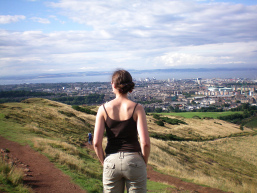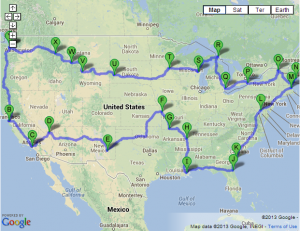Posted October 14, 2013
By RIANNA HIDALGO
In “Song of the Open Road,” Walt Whitman wrote, “Afoot and light-hearted I take to the open road — Healthy, free, the world before me — The long brown path before me leading wherever I choose.”
That is exactly what 27-year-old Katrina Hamilton did last summer, only the path was asphalt-grey, not brown, and she was not on foot. She was in her 2001 Volkswagen Jetta.
“The idea of circling around the United States on a road trip has been something I thought of for many years,” she said. “If I didn’t do it soon, it was just going to get harder to do it until I retired.”
Whitman wrote his poem in 1856, but more than a century and one=half later, people like Hamilton are still feeling the call to the “open road.” There is a sense of adventure, freedom and excitement in losing “limits and imaginary lines.”
But a road trip can easily turn into an ordeal where family members bicker and passengers are hungry and exhausted, with full bladders and another 30 minutes to the nearest town.
To avoid that kind of road trip, the common thread of advice from experienced road trippers is simple.
Do not over-plan.
Road trips can be scheduled down to Wednesday’s lunch entrée, but many say having flexibility – both mentally and logistically – is the best way to create a fulfilling experience.
When University of Miami student Abigail Berkowitz went on a cross-country road trip with her family, strict time constraints, a rigid itinerary and months of planning to concoct the “perfect” trip ruined the fun.
“We stopped at every touristy thing we could and we were trying to cram in too many things,” she said. “Don’t get caught up in trying to make the most of everything. You’ll get more out of the trip if you let what happens happen.”
Andrew Van Winkle, founder of roadtripwise.com, embodies the “go with the flow” approach. After at least 100 road trips, he has developed an almost mystical methodology and follows his instincts on the road.
“I would feel that I’ve let myself down if I’ve decided what my road trip will look like before I’ve left the house,” he said. “When I research my route, I’m careful not to get too attached to things along the way. I’d rather allow the unexpected surprise me.”
One of the pros to less planning is that when things go wrong, it’s not the end of the world.
One week into her solo road trip around the U.S., Hamilton thought her ride was unusually bumpy. A few minutes later, she was stranded in the middle of an Oregon road, tire flat and shredding like a coconut. Within a few minutes, a crowd of locals had gathered to help and it wasn’t long before she was back on the road.
“Everything that happened was an experience – that was just an interesting story,” Hamilton said. “It’s one part of one great adventure, and you can’t have everything go right on a big adventure. I gave myself the freedom to think, ‘you know, some things are not going to work out.’”
Logistically, limiting hotel or activity reservations also allows the traveler to take advantage of opportunities as they show up. Hamilton said one of her favorite experiences was an unexpected river rafting trip with some other travelers. If she needed to get to a certain place by a certain time, she would have passed it by.
Finding balance
Of course, leaving things to chance isn’t for everyone, and how much you plan depends on a variety of logistical and personal factors. Are you traveling with family or children? Do you have limited time for your trip or have to be somewhere by a certain day? Will leaving things to chance make you more anxious than it’s worth?
Now that he travels with his wife and kids, Van Winkle has had to adjust and add more structure to his expeditions for his family’s sake.
“I book hotels in advance and I don’t go as far off the beaten path,” he said.
For many travelers, finding balance is key. The most successful trips seem to be a combination of planning ahead for a couple of key destinations and playing the rest by ear.
Hamilton, for example, knew she wanted to hike to the bottom of the Grand Canyon and needed a reservation to camp for the night.
That goes for hotels as well. It is feasible to take an exit and find the nearest motel, but if you know you want to stay in a popular place during a busy time of year, it’s best to call.
“Think ahead of time about what is really important to you and research those things,” Hamilton said. “Let everything else be ‘if it works it works, if it doesn’t it doesn’t.”
Regardless of what you plan and don’t plan, the most important thing is not to lose sight that on a road trip, it’s about the journey, not the destination.
“The biggest mistake I see people make is not paying attention. It’s like they get blinders on,” Van Winkle said. “The road becomes monotonous. They only see their road trip as a means to get somewhere and either they’ll miss some kind of divine magic or get really uncomfortable – or both.”
Your wheels
While winging a road trip might sound liberating, a little bit of planning is unavoidable and of all the things to leave up to chance, vehicle safety is not one of them.
Orestes Triana Jr., former president of the Automobile Service Association of Florida and owner of Green’s Garage in Miami, said it’s essential to take your car to a mechanic to get a fresh oil change and have it inspected before long-distance driving.
“Nothing is going to guarantee 100 percent that a car is not going to break down,” he said. “But you can do a lot of preventative maintenance for the future. If the car was checked out prior to leaving, then you should be good to go.”
Roadside assistance is also a good idea, and it is automatically included in many insurance plans. Some organizations, like AAA, even offer discounts on hotels and attractions.
When something does go wrong on the road, Triana said never try to get to the nearest exit, because it could turn a minor repair into a major engine problem. Pull over, wait and call for a road ranger who can help you get to a service station, especially if you are on a busy highway.
“It can be very dangerous on the side of the road,” he said. “You really don’t want to have anyone outside of the vehicle.”
Some other important tips: Make sure you have a flashlight in case you need to flag someone down at night and always keep your fuel at a minimum of a quarter tank.
Weather the storm
When Maryse Smiley was driving with her husband to Texas, extreme winds in Arizona sent a tree flying into the middle of the freeway. Luckily, no one was hurt, but they were certainly caught off guard.
Bruce Thomas, president of the National Weather Association, said it’s best to check the forecast before leaving for the day on the federal government’s official weather website, weather.gov.
There are also several cellphone weather applications. Thomas’ favorites are MyWarn and RadarScope, which use your phone’s GPS to track your location. To stay up to date on the road, he suggested purchasing a National Oceanic and Atmospheric Administration weather radio.
If you know you will be driving in snow and ice, there are special precautions.
“Driving conditions during winter weather events can be extremely treacherous and should always be respected,” Thomas said. “Having the right equipment is very important.”
That means driving a car with front-wheel or all-wheel drive, as well as snow and ice rated tires. Chains may be required by law in some mountain passes.
For sanity’s sake
Driving can be boring. It can also be uncomfortable and tiring.
Extra water and lots of snacks are essential. Mark Sedenquist, managing editor of RoadTrip America, also suggested never driving more than 600 miles in a day — about 10 hours maximum.
“Don’t drive as many hours as you think you can,” he said. “Get out of the vehicle at least once every three to four hours and jog, do yoga, the chicken dance, something to get the blood moving.”
Travelers suggested audiobooks and music for entertainment. Of course, there’s no better solution than traveling with someone whose company you enjoy.
Going On A Road Trip?
Helpful websites –
- RoadTrip America has a host of tools for road trips, from articles on eating well on the road to custom mapping programs. Go to www.roadtripamerica.com. Look at routes, attractions and more.
- Andrew Van Winkle’s website, www.roadtripwise.com, has tons of road trip advice from his personal experience. It has some fun sections, like road trip games and motorcycle road trip advice.
- Katrina Hamilton’s blog, www.betterthanithought.com, includes her packing list and entries on planning, organization, and her eye-opening experiences travelling around the country.
- www.weather.gov is the official government weather website with forecasts by zip code or city.
- Onebag.com has an annotated packing list focused on traveling light.
Roadside Assistance –
- AAA costs between $66 and $130 to join for a year. Visit www.aaa.com.
Items –
- NOAA weather radios can be purchased at many retail and online locations, including Best Buy and Amazon.com. They are about $50.
- Smart phone applications, including MyWarn and RadarScope, cost about $10 to download and are on the market for both iOS and Android devices.
- Hamilton suggested a car charger converter, so travelers can charge their laptops and cell phones in the car.



